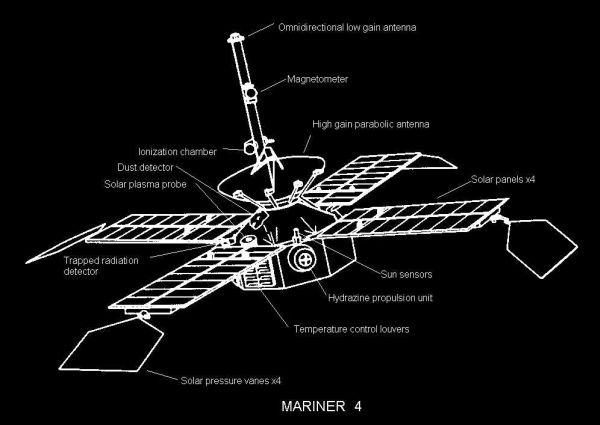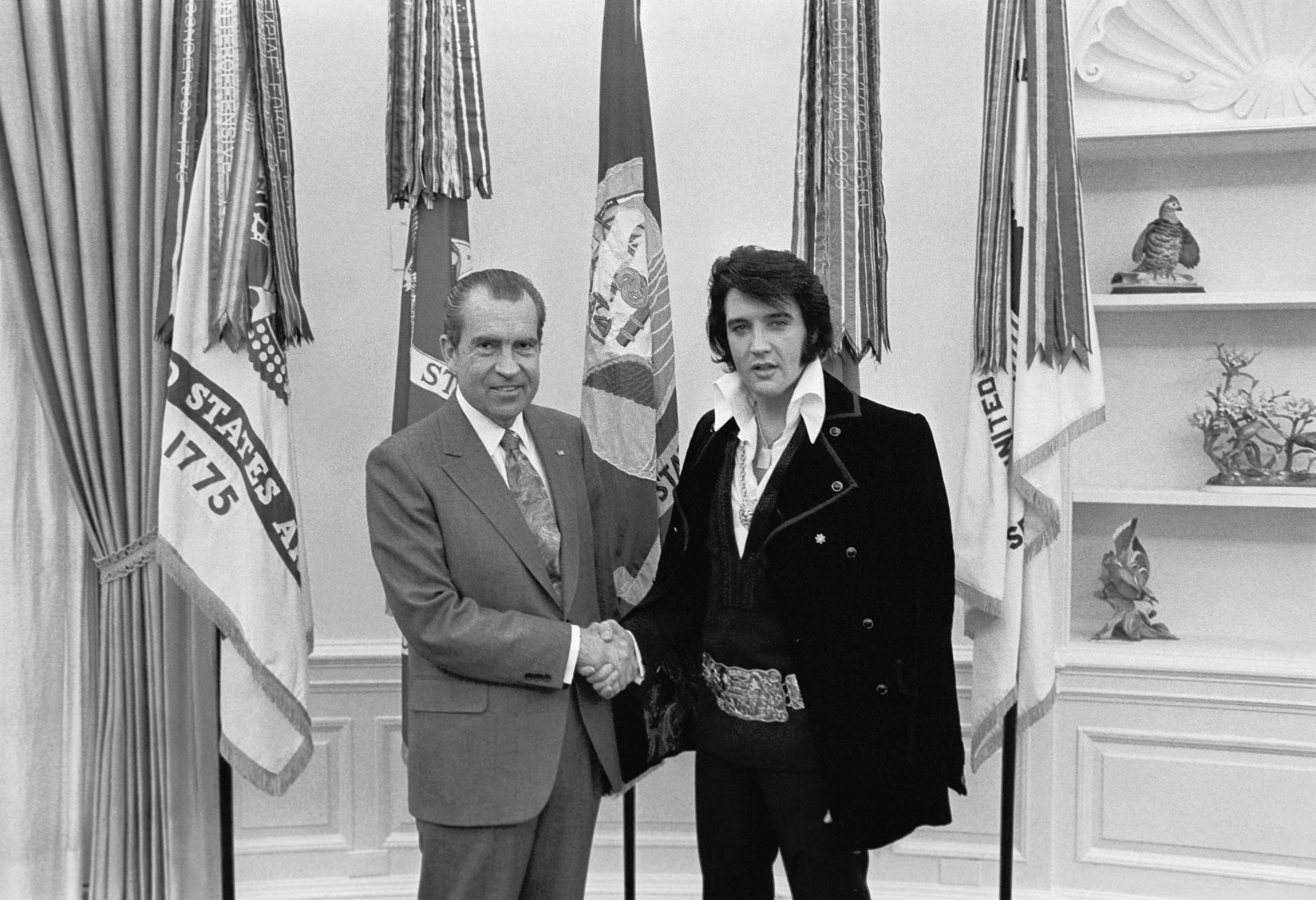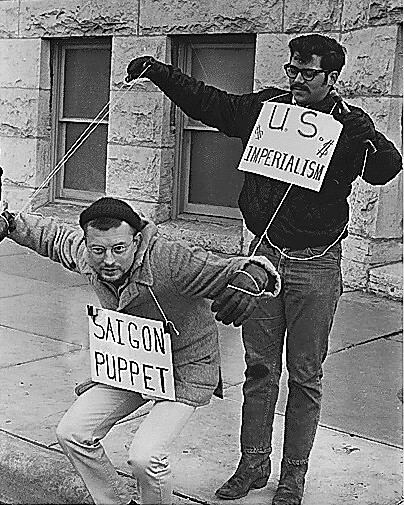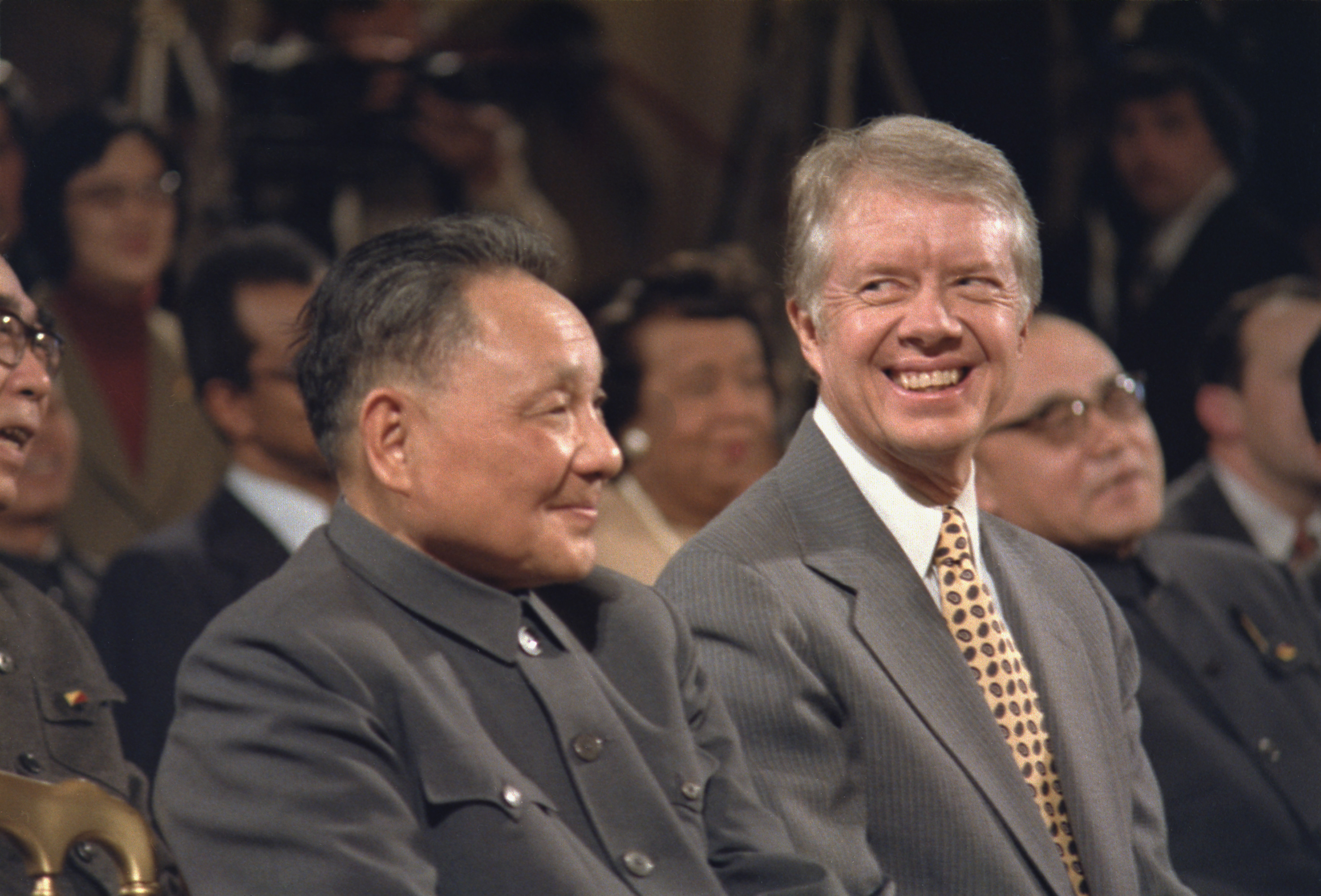
Topics on the Page
The space exploration program
The election and assassination of President Kennedy
Johnson’s Great Society programs
Nixon’s appeal to “the silent majority”
Anti-war and counter-cultural movements
- The Emergence of Baby Boomers
- The Sixties
- Free Speech Movement

The creation of the Environmental Protection Agency (EPA) in 1970
LGBTQ Rights Activism
The Presidency of Jimmy Carter
 Link to AP US History Key Concept 8.3: Postwar Changes in American Society, Politics and Culture
Link to AP US History Key Concept 8.3: Postwar Changes in American Society, Politics and Culture
Focus Question: What were the important domestic policies and events during the Kennedy, Johnson, Nixon, and Carter presidencies?
 For teaching Ideas, see The Sixties: The Years That Changed a Generation from PBS
For teaching Ideas, see The Sixties: The Years That Changed a Generation from PBS
The Space Program
Mariner 4 Spacecraft Diagram, 1964

July 20, 1969: One Giant Leap for Mankind, NASA
SpaceLog presents stories of early space explorations from original NASA mission logs. Includes the famous Apollo 13 mission to the moon and John Glenn's 1962 Mercury mission.
- The physical exploration of space by human spaceflights and by robotics. Some reasons behind the space exploration include scientific research, unification of nations, and survival of humanity.
- Early space exploration was driven by a space race between the United States and the Soviet Union.
- The first man-made object to orbit planet Earth was created by the USSR, it was called Sputnik 1 on October 4, 1957.
- The launching of Sputnik set the United States into a panic mode. They had believed themselves to be ahead of the Soviet Union.
- This launch, at a time when the threat of nuclear war was a very distinct possibility, struck the fear that if the Russians had such technology regarding the space race, they may be more militarily advance than the United States.
- This prompted the United States to focus much more closely on education, especially in the sciences.
- The first landing on the moon was by the Untied States on July 20, 1969 by the Apollo 11.
- Interestingly, as James Michener's novel Space explained, Neil Armstrong was the first man to step on the moon because he was the only civilian on the mission; the other astronauts were military pilots. The U.S. wanted to be clear to the Soviet Union that the mission was a voyage of discovery, not military expansion.
- The first steps of space exploration were made by the Soviet Union when they put the first man in space in 1961. His name was Yuri Gagarin.

Robert Goddard and His First Rocket, 1926

Robert Goddard was an early pioneer in space exploration.
- Konstantin Tsiolkovsky, Hermann Oberth and Reinhold Tilling: set up the groundwork of rocket science in the early 20th century.
- Wernher von Braun was the lead rocket engineer for Nazi Germany’s World War II V-2 project. He was brought to the United States to work on U.S. rocket developments.
- During the final days of World War II rocket technology was obtained by the United States and Soviets.
- John Glenn was the face of the American Space program.
- John Glenn's story was the ideal astronaut archetype.
View a timeline on space exploration here
Robert Lawrence, Jr.
John F. Kennedy and the Election of 1960
John F. Kennedy was the first Irish Catholic president to be elected in the United States. This milestone was the first of many steps in the diversifying of the United States population. He was elected on a groundswell of future-minded optimism that gripped the country in the afterglow of post war prosperity.
- JFK, as he was known, presented a youthful optimism that was a model for progressive policies such as the Peace Corps.
Click here for a biography of JFK
We Knew JFK: Unheard Stories from the Kennedy Archives
First Televised Kennedy-Nixon Debate, September 26, 1960
 Click here to go to the JFK Presidential Library.
Click here to go to the JFK Presidential Library.
- Click here for lesson plans on the JFK presidency through PBS.
- Click here for lesson plans on JFK from the New York Times.
JFK and Civil Rights
Kennedy's legacy concerning the Civil Rights movement is a subject of controversy.
- No major Civil Rights laws were passed during his presidency, but he did take other steps to advance the cause.
- In 1962, he sent the National Guard to Ole Miss University to ensure the safety of James Meredith, a newly enrolled black student in the previously all white school.
- To learn more about the integration of Ole Miss and the riots that followed, click here.
Go here for The Phone Call, a graphic comic documenting a phone call between then Senator John F. Kennedy and Martin Luther King, Jr. that influenced the outcome of the 1960 Presidential election, from PBS American Experience.
The Assassination of President Kennedy
The Zapruder film
- Friday November 22, 1963 at 12:30 p.m. in Dallas, Texas USA
- President Kennedy was killed by gunshots in a presidential motorcade when he was riding with his wife Jacqueline Kennedy
- President Kennedy wanted to visit Dallas for three main reasons: 1) Help the Democratic Party in the presidential campaign, 2) to begin his campaign for re-election, and 3) to mend political issues with Texas.
- President Kennedy would drive from Love Field airport in the motorcade through downtown Dallas to give a speech at the Dallas Trade Mart.
- The motorcade he was driving in was a 1961 Lincoln Continental, which had an open-top. There wasn’t a presidential car with a bulletproof top made yet.
- An investigation took place for over 10 months. The conclusions was:
- The assassin was Lee Harvey Oswald, an employee of the Texas School Book Depository.
- The United States House Select Committee of Assassinations believes that Kennedy was assassinated by Oswald as a result of conspiracy.
- The route of travel had been described in a Dallas newspaper with specific details, allowing for the assassination to have easy planning.
- Before Oswald could be tried for the crime, a Dallas dance hall owner Jack Ruby shot and killed him.
Report of the President's Commission on the Assassination of President Kennedy.
November 22, 1963: Death of the President For more, see Who was Lee Harvey Oswald? from Frontline.
Transition of Presidencies
After JFK's Assassination, Lyndon B. Johnson was sworn in as president on an airplane, while Jacqueline Kennedy was still in her clothes covered with her husband's blood.

Time article detailing the above photo and biography on the women swearing LBJ in: http://time.com/5457324/lbj-swearing-in-sarah-hughes/
Documentary, "Four Days in November", about the immediate aftermath of the assassination and the transition of power
https://www.youtube.com/watch?v=nH7JukZHtdE

Link to President Johnson's address to congress 5 days after the assassination: https://www.history.com/speeches/lyndon-johnsons-address-to-congress-after-kennedy-assassination
President Johnson's remarks upon arriving at Andrews Air Force Base, 11/22/1963: https://www.archives.gov/historical-docs/todays-doc/?dod-date=1122
Lyndon Johnson’s Great Society Programs
Click here for a biography of LBJ
- The Great Society was a program designed to fix societal problems including aid to education, attack on disease, Medicare, urban renewal, conservation, development of depressed regions, fight against poverty, crime prevention, and the removal of the obstacles of the fight to vote.
Johnson's Great Society Speech, 1964
- Federal aid to education: great emphasis on poor children.
- Elementary and Secondary Education Act of 1965- large amounts of federal money went to public schools. This would help all school districts.
- Higher Education Act of 1965- funding for lower income students. Included grants, work-study money, and government loans.
- The National Endowment for the Humanities and National Endowment for the Arts- supported humanists and artists.
- Poverty tax-reduction laws were passed.
- Economic Opportunity Act- attempted to promote good health, education and welfare to the poor.
- Click here for a brief video about LBJ's "War on Poverty."
- Medicare and Medicaid: elderly people were aided by the Medicare amendment to the Social Security, which allowed for more drug coverage.

Lesson plan analyzing the success of LBJ's Great Society from Stanford University
Richard Nixon’s appeal to “the silent majority”
- Refers to the hypothetical majority of people in a country who do not express their opinions publicly.
- President Nixon used it a 1969 speech to refer to the Americans:
- Who did not join in the demonstrations against the Vietnam War
- Who did not engage in riots against police officers
- Who did not engage in the counterculture (a group whose values are different from the social mainstream ideas of the time).
- Who did not participate in public discourse of the media
- It referred to older generation (World War II veterans) and also young people in the Midwest, West and South, many of whom served in Vietnam.
- The silent majority consisted of many blue collar people who apparently didn’t have time to participate in these junctions.
- Some say it was Nixon’s method of dismissing protests going on in the country, but he wound up winning the presidential election by taking 49 of the 50 states (dropping only Massachusetts and Washington, D.C.).
- Watch a clip of Nixon's Silent Majority speech, here

For an interesting cultural moment, see When Elvis Meet Nixon, December 21, 1970 from the National Archives.
 Click here to go to the Nixon Presidential Library and Museum
Click here to go to the Nixon Presidential Library and Museum
 Does the Constitution Allow for Indictment of the President?
Does the Constitution Allow for Indictment of the President?
YES
NO
A Sitting President's Amenability to Indictment and Prosecution, United States Department of Justice (October 16, 2000)
High Crimes and Misdemeanors, Constitutional Rights Foundation
Impeachment, from the House of Representatives
Impeachment, from the website of the U.S. Senate
Teaching Resources
Anti-Vietnam War Protest, Wichita, Kansas, 1967

The emergence of the Baby Boomers
The 1950s and 1960s saw a dramatic outburst of energy from the "Baby Boomers". The term "Baby Boomers" refers to a generation born after World War 2 in a population explosion.
FACTS about the 1950s. * Population 177,830,000
- Unemployment 3,852,000
- National Debt 286.3 Billion
- Average Salary $4,743
- Teacher's Salary $5,174
- Minimum Wage $1.00
- Life Expectancy: Males 66.6 years, Females 73.1 years
- Auto deaths 21.3 per 100,000
- An estimated 850,000 "war baby" freshmen enter college; emergency living quarters are set up in dorm lounges, hotels and trailer camps.
|
The Sixties (1960 - 1969)
Watch Crash Course in US History: The 60s here
The sixties were the age of youth, as 70 million children from the post-war baby boom became teenagers and young adults.
- The movement away from the conservative fifties continued and eventually resulted in revolutionary ways of thinking and real change in the cultural fabric of American life.
- No longer content to be images of the generation ahead of them, young people wanted change. The changes affected education, values, lifestyles, laws, and entertainment.
- Many of the revolutionary ideas which began in the sixties are continuing to evolve today.[10]
 LGBTQ Rights Activism and the Stonewall Riots
LGBTQ Rights Activism and the Stonewall Riots
The 1960s and 1970s not only witnessed increased civil rights activism, but activism for the rights of LGBTQ people as well
For background, see The American Gay Rights Movement
Timeline of milestones for the Gay Rights Movement: https://www.cnn.com/2015/06/19/us/lgbt-rights-milestones-fast-facts/index.html
ACLU page on the advancements of LGBTQ Rights Movements, and how the fight continues today: https://www.aclu.org/other/rights-lesbian-gay-bisexual-and-transgender-people
Elaine Noble and Kathy Kozachenko: The First Openly LGBT People to be Elected (1974)
The Counterculture Movement
Anti-war and counter-cultural movements
The Generation Gap
The "Generation Gap" refers to a term used to describe the vast difference in world view between the generations born pre- and post-World War 2.
Roots of the Counterculture Movement
Click here for a documentary on the Counterculture
Within the 1960s and into the 1970s, young people questioned America's materialistic, cultural, and political norms. Seeking an improved world, some used music, politics, and alternative lifestyles to create what came to be known as the counter-culture. Americans in that era faced many contested issues, ranging from civil rights, the Vietnam War, nuclear arms, and the environment to drug use, sexual freedom, and nonconformity. The counterculture lifestyle connected many of the ideals and indulgences of the time: peace, harmony, music, mysticism, and religions outside the normal Judeo-Christian custom. Meditation, yoga, and psychedelic drugs were embraced as routes to expanding one's consciousness and, therefore, bettering one’s life.
The counter-culture movement, along with the anti-war movement, was greeted with enormous publicity and popular interest and contributed to enormous changes within American culture. These movements challenged authority, promoted greater social tolerance, felt that politics were personal, promoted environmental awareness, and embraced new attitudes about gender roles, marriage, and child rearing.
Many children of the sixties counter-culture dropped out of school or ordinary life and left the cities for the countryside to experiment with utopian lifestyles. Away from urban problems and suburban conformity, they built new lives structured around shared political goals, farming, and community living. As part of a spiritual reawakening, some members of the counterculture rejected drug use in favor of mind and spiritual expansion through yoga, meditation, and chanting.
Many people refer to the Woodstock festival in 1969 as the peak of the counter-culture.[1]
The Free Speech Movement
College campuses in the 1960s were at the center of the counterculture movement. Anti-War and Civil Rights riots were common at colleges all over the nation. Some schools that were especially notable for their protests include Harvard, Columbia, and Cal-Berkeley.
- To learn about the Free Speech movement at Cal-Berkeley, click here.
- To read some quotes from the movement's leader, Mario Savio, click here.
 |
| Mario Savio greeting Free Speech Movement supporters at Cal-Berkeley. |
Environmental Protection Agency (EPA)

The Environmental Protection Agency (EPA), an independent agency of the U.S. government, with its headquarters in Washington, D.C., was established in 1970 to reduce and manage air and water pollution, noise pollution, and radiation and to ensure the safe handling and disposal of toxic waste substances.
- The EPA is interested in research, monitoring, and the setting and enforcement of national standards on environmental issues.
- It administers the Environmental Response, Compensation and Liability Act of 1980, which is aimed at restoring toxic waste sites by making the responsible parties finance their own cleanup.
- It also issues statements on the impact of operations of other federal agencies that are detrimental to environmental quality, and it supports the anti-pollution activities of states, municipalities, and public and private groups.
Before the EPA was established, the central government was not adequately structured to make a coordinated attack on harmful pollutants being emitted into the environment. The EPA was formed to repair damage already done to the natural environment and to establish guidelines for American businesses and citizens to follow.[2]
 Timeline of the EPA and its history.
Timeline of the EPA and its history.
The Presidency of Jimmy Carter
 |
| President Jimmy Carter with Chinese leader, Deng Xiaoping, January 1979 |
Jimmy Carter "Crisis of Confidence" Speech, July 15, 1979.
For background on the "Malaise Speech," see "What the Heck Are You Up To, Mr. President?" Jimmy Carter, America's 'Malaise,' and the Speech That Should Have Changed the Country by Kevin Mattson (Bloomsbury USA, 2010).
Examining Carter's 'Malaise Speech," 30 Years Later from NPR.
 Click here for the Carter Presidential Library.
Click here for the Carter Presidential Library.
Works Cited:
[1] Barringer, M. (1999). Retrieved May 2, 2007, from The Anti-War Movement of the US Web site: http://www.english.uiuc.edu/maps/vietnam/antiwar.html
[2] (2007). U.S. Environmental Protection Agency. Retrieved May 2, 2007, Web site: http://www.epa.gov/
[3] (2007). Watergate. Retrieved May 2, 2007, from Watergate: The Scandal that Brought Down Richard Nixon Web site: http://watergate.info/
[10] (2010). Baby Boomer facts. [Web]. Retrieved April 19, 2010, from http://kclibrary.lonestar.edu/decade60.html
http://www.britannica.com/eb/article-9069273/Sputnik http://www.britannica.com/eb/article-9045085/John-F-Kennedy
Comments (0)
You don't have permission to comment on this page.